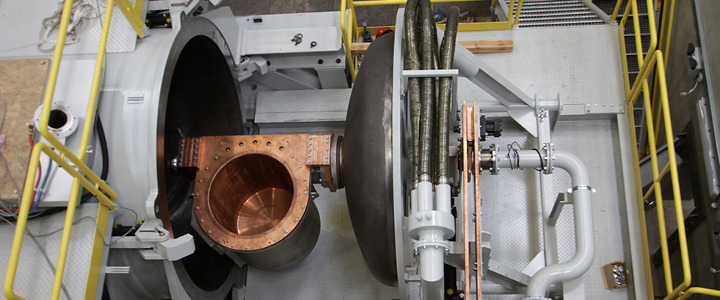Europe's biggest aerospace castings facility nears completion
14 November 2016A new plant capable of producing some of the biggest Titanium aerospace castings in the world is nearing completion at AMRC Castings’ facilities on the outskirts of Sheffield, England.
Two large scale power supply units have been installed to deliver the energy required by the organisation’s new Retech Consumable Electrode Casting Furnace.
The furnace is capable of melting the 1000kg of Titanium required to make a 500kg casting and has three interchangeable bodies, which give it the versatility to produce components with a finished weight ranging upwards from 60kg.
Closed loop cooling systems that prevent the furnace bodies themselves from melting are being installed, along with hydraulic and pneumatic systems, which carry out a number of functions, including removing air from the furnace and casting chambers – essential when dealing with molten Titanium, which reacts violently with oxygen.
The systems are also used to rotate the furnace body to pour molten Titanium into a ceramic mould in the casting chamber below, which incorporates a turntable that can spin the mould at up to 300 revolutions a minute to create a high quality centrifugal casting.
A new plant is being installed to make ceramic mould shells up to two metres in diameter and 2.5 metres long which could weigh more than 2.5 tonnes and will be large enough to produce the largest variants of aero engine intercases up to 500kg, and other structural aerospace components.
Furnace construction is due to finish in time for training and cold commissioning to start during November and will be followed by hot commissioning and the first test melts in December, depending on when permission is given to energise the power supplies.
AMRC Castings, part of the University of Sheffield Advanced Manufacturing Research Centre (AMRC), has extensive expertise in manufacturing smaller Titanium castings and its technology has been used to produce Titanium castings with a poured weight in excess of 300kg, demonstrating its scalability.
Initial casts will be poured into a static metal mould before trials begin using static ceramic moulds from the new shelling plant. Staff will then start building up the experience needed to operate the centrifugal casting system at full speed.
AMRC Castings’ new furnace is part of a major investment and R&D programme, designed to enable UK companies to break into global markets for large-scale Titanium aerospace engine and structural components.
The programme is backed by the UK’s Aerospace Technology Institute (ATI); its innovation agency, Innovate UK; and High Value Manufacturing Catapult funding and will help to ensure the UK retains its place as the second-largest national aerospace industry in the world and the largest in Europe.
In the past, only the United States is believed to have had the capability to cast near net shape aerospace components weighing up to 500kg.
“We plan to create a world class Titanium casting capability in the UK developing the skills base necessary to enable companies to reap the rewards of carrying out a process that is very, very challenging,” says AMRC Castings’ Richard Gould.
In addition to the new furnace and shelling plant, AMRC Castings has expanded its capacity for producing large scale dimensionally accurate replica patterns.
The organisation has acquired an SLA 3D printer that can make components for replica patterns that are up to 650mm by 750mm by 550mm from photosensitive epoxy resin and a bespoke CMS Poseidon 5 axis CNC machine which can make single piece pattern components up to 2.6×4.0x2.0 metres from polystyrene.
It has also invested in a Teubert moulding machine to make expanded polystyrene patterns using metal tooling for longer production runs and a Pacific Kiln Furnace large enough to fire the ceramic moulds its new shelling plant can produce.



